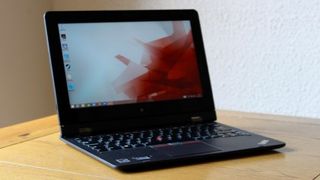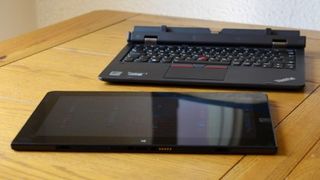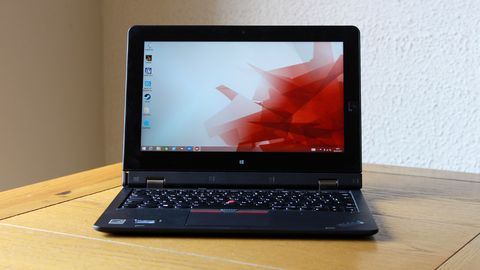Why you can trust TechRadar
There are three ThinkPad Helix variants listed on Lenovo's site. The "low-end" variant comes with a dual-core, four-thread Intel Core M-5Y10c, which has a maximum clock frequency of 2GHz. The other two pricier models have a faster Core M-5Y71, with a base frequency of 1.2GHz, but in Turbo Mode, this goes up to 2.9GHz, a high clock speed for a tablet.

8GB of memory comes as standard in all models, as does a 1920 x 1080 display, which Lenovo touts as capable of 400-nit brightness. As I was sent a high-end model with a Core M-5Y71, it came with an Intel HD5300 integrated graphics chip, which isn't quite the performer the HD5500 is (that's what you get with Intel Core i5 processors as seen on, for example, the ThinkPad Yoga 12).
There are multiple batteries, one in the dock, one in the tablet itself, with two power connectors to charge either separately. They behave as you might expect. The primary battery is in the tablet itself. When connected, the dock charges the tablet, and if it is left disconnected from a power source, it's the dock's battery that powers the Helix – and obviously when you remove the tablet, then it's using its own battery.
The dock and keyboard also house separate speakers, with a mono speaker in the tablet and stereo speakers in the dock, which inevitably produce a more powerful sound. And as is the case with the batteries, when the two are conjoined, the audio switches back to the dock by default, with a pause of a few seconds as it does so.

A 128GB SSD is present in the entry-level and mid-range models, while the high-end variant has a 256GB SSD, which supports Opal 2.0 self-encryption.
Dual-band 802.11ac wireless connectivity is catered for with an Intel 7265 wireless chip, as used in many mobile devices.
The Helix also comes with an Active stylus on the low-end models, with a Digitizer Pen in the high-end model, offering 256 levels of pressure sensitivity, although this can be purchased separately on Lenovo's site.
Here is the spec sheet of the review model provided to TechRadar:
- CPU: Intel Core M-5Y71
- Graphics: Intel HD5300
- RAM: 8GB
- Screen: 11.6-inch 1920 x 1080 Multitouch
- Storage: 128GB SSD
- Optical drive: None
- Ports: 2 x USB, microHDMI, DisplayPort
- Connectivity: Dual-band 802.11ac Wi-Fi, Bluetooth 4.0
- Camera: 5MP, 2MP
- Weight: Tablet: 759g With dock: 1.35kg
- Size: Tablet: 300mm x 192mm x 9mm

Performance
The Helix is not quite the most powerful tablet around, as it's pipped to the finish line by a few other models, including the aforementioned Lenovo ThinkPad Yoga 12, but it's still a great performer. As with most high-end x86 tablets, expect just about any software you might use on a laptop to run perfectly well on the Helix.
However its CPU and graphics performance can't quite beat a Core i5 and more powerful HD 5500 graphics processor, with slightly lower PCMark and Cinebench performance.
Here are the benchmarks we recorded:
- 3DMark: Cloud Gate: 2922; Sky Diver: 1888; Fire Strike: 504
- Cinebench: CPU: 172 points; Graphics: 17.3 fps
- PCMark 8 Home Test: 1891
- PCMark 8 Battery Life: 5 hrs 41 mins (with dock) 3 hrs 59 min (tablet)
However, there are still some great results here, particularly the battery life. Almost four hours for a Windows tablet in PCMark 8, a quite taxing test, is a very impressive result, and this goes up by close to 50% when the dock is connected.
I also used a Spyder4 Colorimeter to test the display against Lenovo's claims. The result of the uncalibrated brightness test came out slightly lower than the quoted 400 nits, with a result of 361, but this is still good. sRGB coverage of 78% and Adobe coverage of 58% aren't up there with standalone colour-accurate PC monitors or high-end laptops such as HP's DreamColor display, but these results are still more than reasonable.

